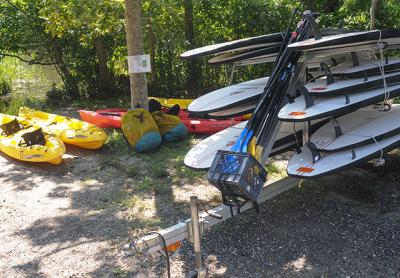Georgica Harvest Ban Is Lifted

A prohibition on the harvesting of crabs and other marine life from Georgica Pond, which has been in effect since July 1 because of the blue-green algae bloom that appeared in June, is being lifted this week, as the East Hampton Town Trustees voted on Monday to remove the signs warning against its consumption or exposure to the pond’s water.
The vote, 5 to 0 with two abstentions, gives the trustees’ clerk authority to close the pond without a vote by the trustee body in the event of a spike in the algae, also called cyanobacteria, as occurred last week. That surge was short-lived and was quickly followed by an equally steep decline to one microgram per liter or less, a condition that persisted as of yesterday.
The vote followed a discussion by the trustees, who manage many of the town’s waterways, bottomlands, and beaches on behalf of the public, as to whether to reopen the pond, which has been closed for varying duration during the last three summers.
“Right now it seems to be fine, it’s holding,” Francis Bock, the clerk, or presiding officer, said of the cyanobacteria bloom.
“We’re now in the third week of August,” said Jim Grimes. “The sun is lower in the sky. The opportunity to create the conditions for this is diminishing, literally by the day.”
Two of their colleagues, Brian Byrnes and Tyler Armstrong, advised a more cautious approach. “It’s risky to make a call,” Mr. Armstrong said, given concern for public health. “I’d like to see the longest period at which it was at zero or a negligible level.”
But the trustees do not meet again until Sept. 12, and “We have the advantage of live data,” Mr. Bock said, referring to the telemetry buoy that is transmitting measurements of cyanobacteria as well as temperature, salinity, dissolved oxygen, and other statistics in 10-minute intervals.
Mr. Grimes rescinded an initial motion to table the discussion, instead moving that the trustees open the pond. Five of the seven members present voted in favor, with Mr. Byrnes and Mr. Armstrong abstaining.
The low level of cyanobacteria persists despite new blooms reported this week in Mecox Bay in Southampton Town, as well as in Riverhead and Calverton.
On the same subject, Sara Davison, the executive director of the Friends of Georgica Pond Foundation, told the board that the effort to remove macroalgae from the pond with an aquatic weed harvester is concluding. The project is intended to determine if removal of the macroalgae, which release nitrogen and phosphorus as they decay, is effective in discouraging cyanobacteria blooms.
“I think we can conclude preliminarily that it was a success,” Ms. Davison said.
The craft will be removed from the pond on or around Sept. 12, she said. Should the foundation ask the trustees’ permission to resume the effort next year, they would use a smaller boat, as it was difficult to maneuver the craft in shallow coves, where the macroalgae growth was densest.
“We did get a little bit of bycatch in the boat,” she added, a concern the trustees had expressed prior to the project’s launch, but said that almost every crab, snapping turtle, and eel swept onto the harvester’s conveyor belt was released unharmed.
Ms. Davison also informed the trustees of groundwater testing at the north end of the pond. Nitrogen is being measured, she said, in preparation for installation of a permeable reactive barrier, a vertical trench filled with wood chips or sawdust that would intercept it before it reaches the pond. By the spring, a year’s worth of data will be compiled and the barrier installed.
“Depending on the findings there, we hope to be able to put up some more around the pond,” she said. “It’s new technology, but results elsewhere have shown that 80 to 90 percent of the nitrogen can be intercepted where groundwater travels through that barrier.”
In an effort to educate property owners as to the effects of fertilizer and pesticide use, the foundation, in partnership with the Perfect Earth Project and the Nature Conservancy, will hold a workshop on low-impact landscaping in watersheds on Oct. 1 at the conservancy’s Center for Conservation in East Hampton. Ms. Davison invited the trustees to attend.
